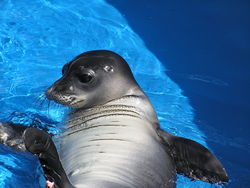Media Watch, PR Web, 26 August 2010
 On Saturday, September 4, 2010, team “Hawaiian Monk Seal” from The Marine Mammal Center will compete in the Maui Channel Swim to support the Center’s efforts to raise funds to build an urgently needed hospital for monk seals in Kona. The female swimmers will join 52 teams and 20 solo swimmers from around the world in a daring 10 mile crossing of the Au Au Channel from the beach at Lanai to Black Rock on the shores of Kaanapali. The channel is well known for dangers to swimmers such as swift currents, tiger sharks, and the Portuguese Man O’ War. The first Maui Channel Swim took place in 1972 and since then, it has grown to become the longest open water relay swim in the world. To help team “hawaiian Monk Seal” achieve their fundraising goal of $11K and save future populations of Hawaiian monk seals, go to: http://www.marinemammalcenter.org/what-you-can-do/events/team-from-the-marine-mammal.html.
On Saturday, September 4, 2010, team “Hawaiian Monk Seal” from The Marine Mammal Center will compete in the Maui Channel Swim to support the Center’s efforts to raise funds to build an urgently needed hospital for monk seals in Kona. The female swimmers will join 52 teams and 20 solo swimmers from around the world in a daring 10 mile crossing of the Au Au Channel from the beach at Lanai to Black Rock on the shores of Kaanapali. The channel is well known for dangers to swimmers such as swift currents, tiger sharks, and the Portuguese Man O’ War. The first Maui Channel Swim took place in 1972 and since then, it has grown to become the longest open water relay swim in the world. To help team “hawaiian Monk Seal” achieve their fundraising goal of $11K and save future populations of Hawaiian monk seals, go to: http://www.marinemammalcenter.org/what-you-can-do/events/team-from-the-marine-mammal.html.


 The NOAA Ship Oscar Elton Sette is at sea for 19 days on a scientific expedition to support Pacific Islands Fisheries Science Center (PIFSC) staff studying monk seals in the remote Northwestern Hawaiian Islands (NWHI).
The NOAA Ship Oscar Elton Sette is at sea for 19 days on a scientific expedition to support Pacific Islands Fisheries Science Center (PIFSC) staff studying monk seals in the remote Northwestern Hawaiian Islands (NWHI). Jeff Walters is the Hawaiian monk seal recovery coordinator for NOAA Fisheries Service. Walters said that in the isolated northwest Hawaiian islands, the number of monk seals is declining by four percent every year. That’s the bad news. But the good news is that a smaller population of seals on the main Hawaiian islands is growing and thriving, he said.
Jeff Walters is the Hawaiian monk seal recovery coordinator for NOAA Fisheries Service. Walters said that in the isolated northwest Hawaiian islands, the number of monk seals is declining by four percent every year. That’s the bad news. But the good news is that a smaller population of seals on the main Hawaiian islands is growing and thriving, he said. Like a glove across the face, KAHEA and the Center for Biological Diversity sent a
Like a glove across the face, KAHEA and the Center for Biological Diversity sent a